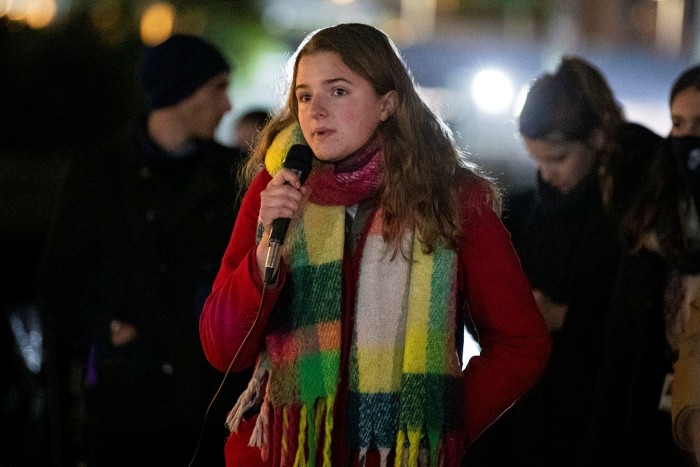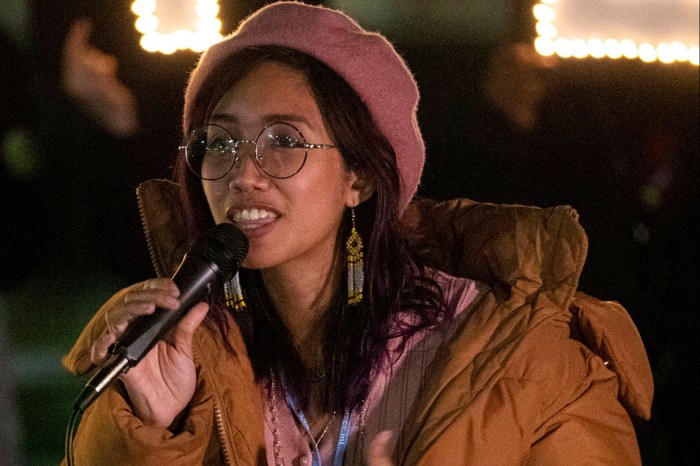‘After Greta’: young activists harness social media to fire up global campaigns
Aiyana Skoles was one of thousands of young climate campaigners who marched through Glasgow on Friday to call for drastic action on climate change. Her call on COP26 negotiators in the Scottish city: an immediate halt to the use of fossil fuels — regardless of the effect on the economy.
“We can’t eat money, so we might as well prioritise the planet,” said Skoles, 19, an international student at Glasgow university. “I feel a lot of disappointment [with world leaders], especially seeing as they are generally very old and they are not going to have deal with the issues that we are.”
The march, organised by the Fridays for Future movement founded by Sweden’s Greta Thunberg, and other protests by young people during the two-week Glasgow summit are highlighting how youth activism has driven climate debate over the past three years.
Skoles said she had been inspired by Thunberg, 18, who started Fridays for Future with other young activists by holding a school strike outside the Swedish parliament in 2018. Thunberg’s campaign has piled pressure on global politicians to step up the pace of pro-climate decision-making.
At a post-march rally, Thunberg repeated her denunciation of COP26 as “a two-week long celebration of business as usual and blah blah blah”, adding that government leaders had to recognise the need for drastic cuts in emissions that would “fundamentally change our society”.
“The facts do not lie and we know our emperors are naked,” she said.

Isabella Villanueva-García, who founded a student congress on sustainability in Chile in 2016, said Thunberg had been the “great example”, sparking the creation of a host of campaign groups.
“I was working on this topic before and I can see the difference between ‘before Greta’ and ‘after Greta’,” said Villanueva-García, 27, who is also an ambassador for the One Young World, an activist community promoting youth representation at COP26.
Thunberg’s 2018 school strike went viral after she posted about it on Instagram and Twitter, and social media have fuelled the rapid spread of youth climate activism.
“Social media have played an absolutely fundamental role in amplifying our struggle,” said Dominika Lasota, 19, an activist with Fridays for Future in Poland. “They have allowed us to connect with other people . . . so we are not left alone, just stuck on our own in this crisis.”

Patience Nabukalu, an activist from Uganda, said campaigning on social media had helped her draw attention to flooding and other climate-related disasters in a country where activists struggled to get a hearing on traditional media. “We are not given a chance [on TV or radio] since climate action is taken as political,” said Nabukalu, 24.
Government leaders are keen to show they are heeding young climate campaigners. At an environmental event this week, Nicola Sturgeon, first minister of the devolved Scottish government, met Thunberg and Ugandan climate activist Vanessa Nakate.
Sturgeon, who has drawn fire for not clearly opposing the development of new oilfields in Scottish waters, said after the meeting that such encounters could be difficult. “Those voices often, including for me, are really uncomfortable at times, because they make us confront the hard realities of our own lack of delivery,” she said.
Justin Trudeau, prime minister of Canada, had credited youthful activists with forcing the pace on climate. “To the young people marching in our streets in cities around the world: we hear you,” Trudeau said in his COP26 speech. “It is true, your leaders need to do better. That’s why we are here today.”
But many activists are furious at leaders for failing to agree the transformative policies scientists say are needed to keep global warming to 1.5C above pre-industrial levels — the target agreed by leaders of the G20 nations last month.
“I think they are hearing us; I don’t think they are listening to us. If they were truly listening we would be seeing action,” said Mitzi Jonelle Tan, a 24-year-old activist from the Philippines.

At the event on the dark banks of the River Clyde opposite the summit site, campaigners summed up their feelings with the illuminated message “End Climate Betrayal”.
The discontent globally with governments’ record on climate easily extends to other areas of policy from conservation to job creation.
“When you think about climate, you say ‘OK, we have a problem’ and then you say ‘What do we need to solve this?’,” said Nasha Ayelén Cuello Cuvelier, founder of an environmental organisation in Argentina. “Climate change can be a door for activists . . . after that they are more involved in other issues.”
Social justice has become a central theme for young activists, who say curbs on carbon emissions must be combined with greater support for developing countries, indigenous people and the most vulnerable in the rich world.
One slogan for the Glasgow march was “Uproot the System”. Placards called for “System Change Not Climate Change” and “Destroy the Patriarchy Not the Planet”.
Thunberg has expressed solidarity with striking Glasgow refuse collectors, some of whom joined the march. “Climate justice means fair pay and good working conditions for all workers!” Friday for Future Scotland declared.
For some, youth activism offers the hope of a shift in influence from older generations that have failed for decades to act decisively on climate change.
But Tan cautioned against associating climate protest too closely with youth. “It’s not adults versus young people,” she said. “We have to make sure we don’t put it in a box as just a youth campaign. It’s everyone’s campaign, really — it’s a fight for our lives.”